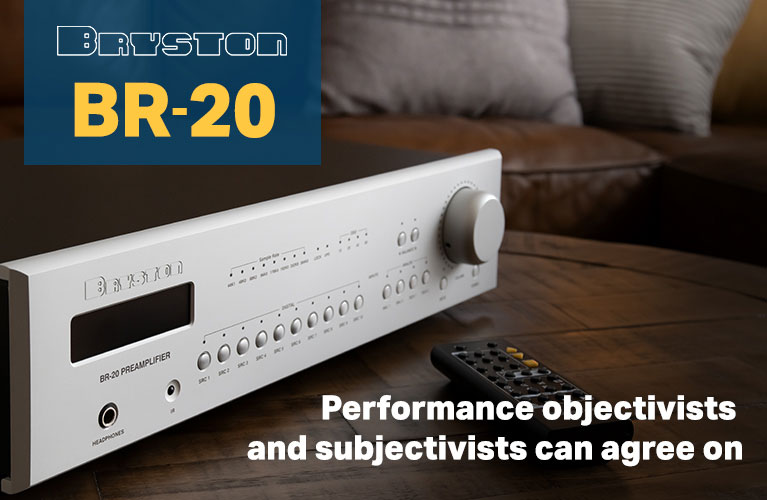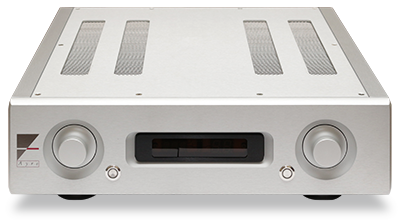
 “I’ll bet you $2.50 that after you review the AX-5, you’ll buy it.”
“I’ll bet you $2.50 that after you review the AX-5, you’ll buy it.”
Whoa! Heavy roller, that Jeff Fritz. He proposed that bet in Las Vegas, at the 2013 Consumer Electronics Show, shortly after Ayre Acoustics’ launch of their AX-5 integrated amplifier ($9950 USD). I didn’t take it, but figured that either Jeff knew he’d win, or he’d just lost a ton of dough at the Venetian’s tables. Or both.
While I’ve been very happy with integrated amplifiers, every once in a while I ponder getting separates -- and so far, the only company that’s come close to tempting me has been Ayre Acoustics. But while their R-series preamplifier and stereo and monoblock power amps have won rave reviews in this and other publications, their prices are a bit high for my budget. So in 2011, when I heard that Ayre would soon add an integrated to its 5 series, which in part is derived from the R models, I was interested.
Design and specs
The AX-7e integrated amplifier has been a member of Ayre’s 7 series for over a decade and has received stellar reviews. However, it puts out only 60Wpc into 8 ohms, and dealers and customers clamored for an integrated with more power. Ayre continuously upgrades all of its models as technology matures or as new technologies come online. According to Ayre’s chief, Charles Hansen, it would have been easy to just update the AX-7e with a higher power output -- but he wouldn’t have been able to guarantee that the AX-7e would remain an excellent amp for the next ten years, based only on refinements of existing technologies. So Hansen and his other designers began with a clean slate, basically trying to bring the KX-R technology down in price while adding the power of the Diamond output stage.
The hallmark of all Ayre products is that they include no negative feedback -- Ayre’s circuit designs are inherently linear. Additionally, every Ayre model is fully balanced from input to output, to better reject hum and interference.
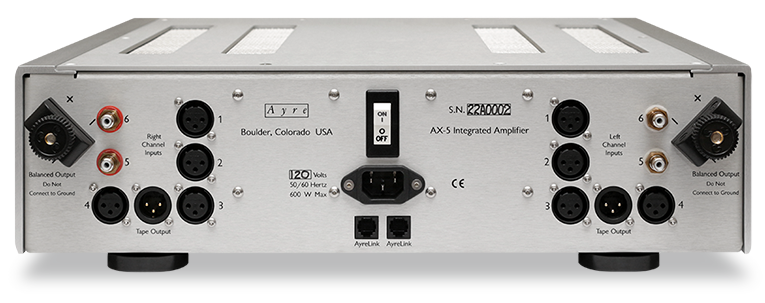
Carried over from KX-R to AX-5 is Ayre’s Variable Gain Transconductance (VGT) circuit; that is, a variable-gain volume control. In a conventional preamp, the noise of the gain circuitry is fixed; the maximum signal/noise ratio is reached only when the volume control is at its maximum setting. When the volume is decreased, the output signal is reduced, but the noise of the circuitry remains the same, and the S/N worsens as the volume is lowered. The advantage of VGT -- which works only in zero-negative-feedback designs -- is that the gain signal is never attenuated. Regardless of the volume setting, the S/N is always at maximum, resulting in a S/N 10-40dB higher than in a typical preamp, and thus much higher resolution and retrieval of more detail. This means that the preamp stage is completely eliminated, and the gain of the power amp is made variable by the VGT.
Also new to the AX-5 (and the new KX-5 preamp) is Ayre’s Diamond output stage, which, Hansen says, “just sounds better.” The Diamond consists of a gateable bridge network of four bipolar transistors, in which the two phases of a signal are recombined to form a full wave, to create an output more faithful to the shape of the input -- again, for maximum fidelity.
What the AX-5 doesn’t share with the R-series components is the latters’ luxe look. Regardless, the AX-5 reflects the handsome design of the other 5 models’ machined-aluminum panels. It’s available in silver and black finishes, both of which look great. My review sample was finished in black.
The Ayre AX-5 measures 17.25”W x 4.75”H x 18.75”D and weighs 46 pounds. At the center of its front panel is the recessed display, machined into the faceplate and illuminated by blue LEDs, which reportedly generate no electrical noise. The LEDs indicate the selected input and the volume level. Flanking the display on both sides, in wells machined into the faceplate, are two knobs, for selecting, naming, and setting up the desired inputs; the right-hand knob also serves as the volume control. Below and between the display and the left-hand knob is a button for exiting the setup menus; in the same position on the right is the Standby button.
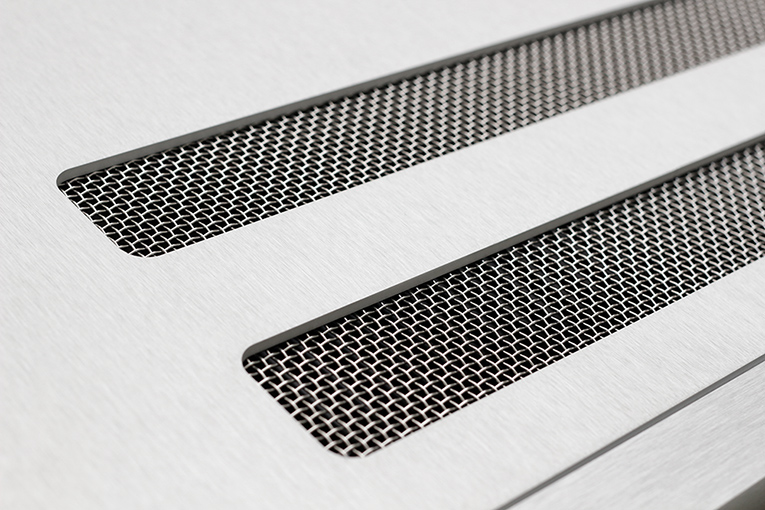
The top plate has four vents, two on each side, with mesh screens; the AX-5 is cooled by convection. On the bottom plate are four feet and six rows of slotted vents, three per side, flanking a central drop-down box for the transformer.
At the center of the rear panel is the master power switch, and just below it an IEC socket for the detachable power cord. Below that are two AyreLink ports, which allow other AyreLink-equipped components to be connected via ordinary two-line phone cables. Flanking these are four balanced XLR inputs, two single-ended RCA inputs, and one pair of tape outputs. Balanced adapters are available from Ayre for those with single-ended source components.
The AX-5 is equipped with a Processor Pass-Through mode for use in a surround-sound system. This allows seamless integration of the front two channels of a home-theater speaker array.
At the rear panel’s upper left and right corners are the best binding posts I’ve ever used. These vise-like posts are so easy to use: Hold the spades against the posts and twist down the knob, which applies pressure to a plate that holds the spades firmly in place.
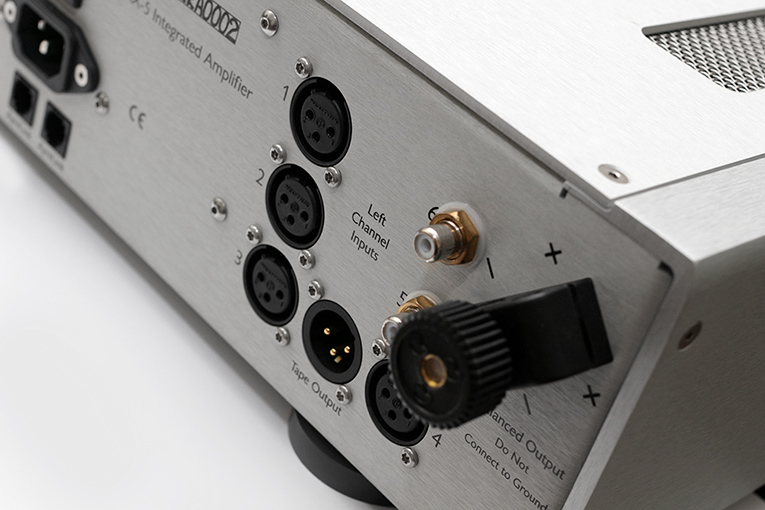
Supplied with the AX-5 is a chunky remote control of machined metal, with (thankfully!) backlit buttons. In addition to the AX-5, the remote can control other Ayre models, such as their CD and universal players.
The AX-5 is a class-A/B design, with a claimed power output of 125Wpc into 8 ohms or 250Wpc into 4 ohms -- enough to drive even the most power-hungry speakers. Gain is specified as 32dB, and the frequency response as DC-250kHz. Power consumption is 48W in standby, 230W in operating mode.
Sound
The Ayre Acoustics AX-5 was at first hard to get a read on -- it added and subtracted less from the music than any other amp in my experience. So seamless and transparent was its sound that it seemed as if there was no component at all between my source and speakers.
The AX-5 kept me engaged in listening sessions that lasted hours at a time. Its sound didn’t grab my attention -- it wasn’t in my face, didn’t seize me by the lapels and demand that I listen. Instead, in every listening session, its consistency and purity of tone, and its wonderful sense of tempo, captivated me.
Although the review sample had seen some action prior to being sent to me, it seemed to need more burn-in before all the musical details fully developed and bloomed. After a few weeks its sound was much more clear, with a wealth of detail and textures even at low volumes that I usually notice only at higher SPLs.
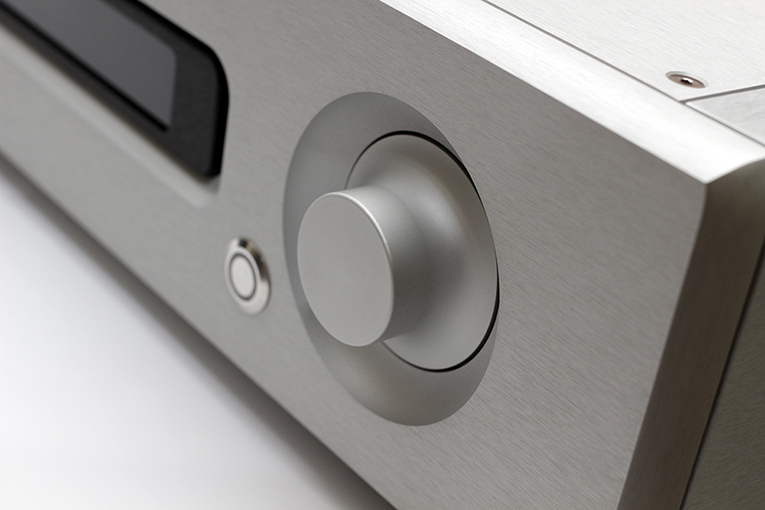
Each morning, I wake very early and read the newspaper online as music plays in the background -- the rest of the family is still asleep, so I have to keep the volume quite low. With the AX-5, I could play music at volumes much lower than usual and enjoy it just as much as I do at higher levels -- especially helpful with classical music and jazz. However, still concerned that the sound was too loud, I often stepped out of the room and closed the door behind me. Although what I now heard through the closed door was barely audible, inside my listening room the music had seemed far from quiet -- something I can attribute only to the AX-5’s high sound quality at these new, lower SPLs. To my wife’s great relief, throughout the review period I listened at much lower volumes than I have in the past.
But when no one else was home, I really let ’er rip. The AX-5 did not disappoint. Regardless of whether it was a large-scale symphony or bone-crushing heavy metal, the Ayre handled the music flawlessly, and never once came close to running out of juice or showing any sign of strain. One of my favorite rhythmically dense, headbanging tunes is “Cochise,” from Audioslave’s Audioslave (16-bit/44.1kHz AIFF, Sony). Turning the AX-5 up to “11” with this track had “Cochise” figuratively exploding from my speakers, and inspired me to follow it with the equally addictive and pounding “Bulls on Parade,” from Rage Against the Machine’s Evil Empire (16/44.1 AIFF, Sony). With these two tracks, the sound was punchy and tight, with all the subtle impact of a sledgehammer.
When a lighter touch was required, the AX-5 easily switched gears to convey the necessary delicacy. I’m not a huge fan of baroque music, but I often use it when evaluating a component because this type of music is very sensitive to amplification. Through the AX-5, the violins in J.S. Bach’s Brandenburg Concertos, with Marek Stryncl conducting Musica Florea (16/44.1 AIFF, Supraphon), had a gorgeously shimmering tone and airiness. There was no trace of glassiness or edge, just wonderful, beautiful music.
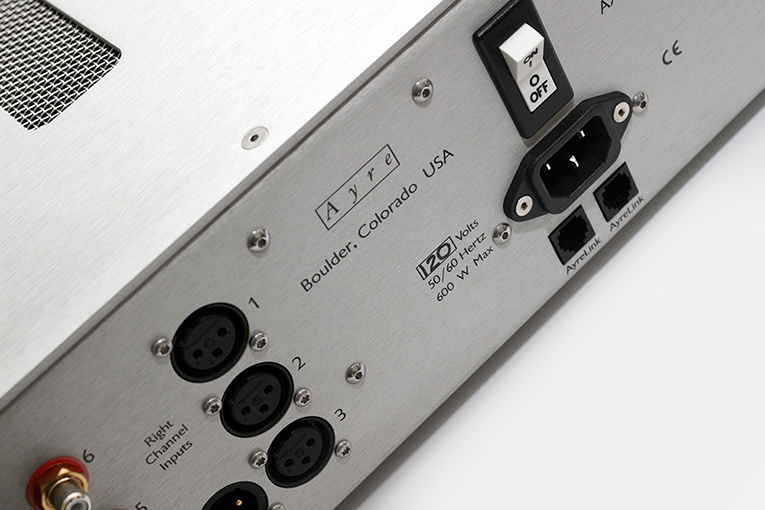
The AX-5 didn’t seem to favor one genre over another. No matter what sort of music I listened to, it was pleasurable; I never found myself wishing for a little more of any particular quality. In fact, I found myself switching among genres more frequently than usual, segueing from classical to heavy metal to jazz fusion. I also listened to many recordings I’d recently neglected, just to get an idea of how they would sound through the Ayre.
Soundstaging was both broad and deep, and the stage width was particularly generous, frequently extending well past my speakers’ outer boundaries. Hall reverb and decay were particularly notable, especially with classical recordings. With Eugene Bozza’s Children’s Overture, performed by the Norwegian Armed Forces Staff Band, from the 2L-TWBAS 2012 Sampler (24/176.4 FLAC, 2L/SoundStageRecordings.com), the sense of spaciousness testified to the AX-5’s ability to convey these qualities.
Comparison
My 13-year-old integrated amplifier, a Jeff Rowland Design Group Concentra ($5600 when available), suffered in comparison to the Ayre AX-5. The Rowland’s treble was harder and its bass was softer -- the inverse of what I wanted. These were not subtle differences, and were hard to ignore. More important, the Concentra’s midrange seemed too warm in comparison with the AX-5’s neutrality and transparency, and made the music sound as if wrapped in gauze. Additionally, images were less focused and soundstages were more constricted. While I’d been able to forgive the Concentra’s shortcomings in some previous reviews, this time I found it much harder to do.
Since the AX-5 was so much better than the Concentra, I felt that comparisons of the Ayre with some of my favorite previously reviewed amps were warranted. Aural memory is notoriously unreliable, but going back over my listening notes, I found three amps that excelled and left behind enduring memories of their transparency and soundstaging -- and, more specifically, their treble (ASR Emitter I, $10,950), midrange (Esoteric A-100, $19,000), and bass (Luxman L-509u, $10,000). Each of these amps is very transparent; I’d now be hard-pressed to state a distinct preference among them, but the ASR Emitter I would probably get the nod. Additionally, each had soundstaging to spare, though I’d be lying if I said I could remember which outshone the rest. Tonally, the ASR Emitter I had a sparkling and crystalline treble, the Esoteric A-100 had a luscious and warm midrange, and the Luxman L-509u had an iron grip on the bottom end.
If you assumed that I would say that the AX-5 beat all of them in all categories, you’d be wrong. Each of these amps has individual characteristics that stick out in my memory as examples of excellence, and might still surpass the AX-5 in that category. But none of them was as consistently excellent across the board in every parameter as was the AX-5. The ASR, Esoteric, and Luxman are among the finest amps I’ve heard, but the winner is the Ayre AX-5.
Conclusion
I try to avoid hyperbole, or stating that one or another component is the best I’ve ever heard. Any component I’ve ever heard might someday be surpassed by a future component, and the Ayre Acoustics AX-5 is no exception. But as of today, the AX-5 is not only, overall, the finest-sounding amp I’ve ever heard, it ranks as one of the finest components I’ve heard of any type. Or, to put it another way while emphasizing one of its strongest suits: This is the best damn integrated I’ve never heard. The AX-5 is truly a Goldilocks amp: not too hot and not too cold, it’s just right.
Of all the components I’ve owned in the last 13 years, the Jeff Rowland Design Group’s Concentra integrated amplifier has served me longest. Sad as it may be, I feel that it may soon be time to bid it adieu. While I have a very comfortable income, my wife is in the process of establishing a new business, so much of my non-retirement savings are going into her startup costs. As a result, my hobby is now more of a luxury than ever. Regardless of that, you can take this to the bank: By hook or by crook, the Ayre Acoustics AX-5 will be mine. It’s a good thing I never took Jeff’s bet.
. . . Uday Reddy
udayr@soundstagenetwork.com
Associated Equipment
- Loudspeakers -- Revel Ultima Salon2, Audioengine A2
- Integrated amplifier -- Jeff Rowland Design Group Concentra
- Digital sources -- Meitner Audio MA-1 DAC; Apple Mac Mini running OSX 10.9 with JRiver Media Center 19, remote-controlled by JRemote via iPhone; Devilsound USB DAC; Halide Design S/PDIF-USB interface; Logitech Transporter
- Interconnects -- Cardas Audio Neutral Reference XLR and RCA interconnects, Cardas Clear USB interconnect, Halide Design S/PDIF asynchronous USB Bridge with BNC termination
- Speaker cables -- Cardas Audio Neutral Reference
- Headphone system -- Sennheiser HD 600 headphones with Cardas Audio headphone-cable upgrade, Ultimate Ears UE 11 Pro earphones, Ray Samuels Audio Emmeline The Predator headphone amplifier
- Accessories -- Audio Power Industries Power Pack II power conditioner; Cardas Audio Twinlink and Cross power cords; Cardas Audio Signature XLR, RCA, and BNC caps; Cardas Audio/Ayre Acoustics Irrational, But Efficacious! system-enhancement disc
Ayre AX-5 Integrated Amplifier
Price: $9950 USD.
Warranty: Five years parts and labor.
Ayre Acoustics, Inc.
2300-B Central Avenue
Boulder, CO 80301
USA
Phone: (303) 442-7300
Fax: (303) 442-7301
Website: www.ayre.com






















